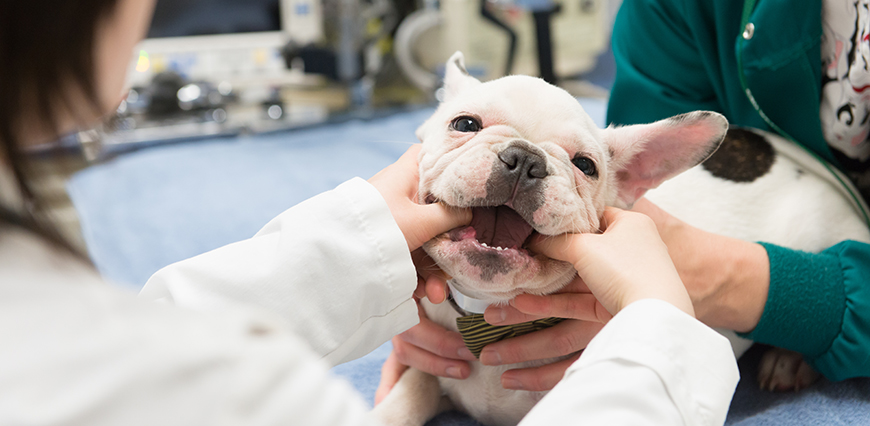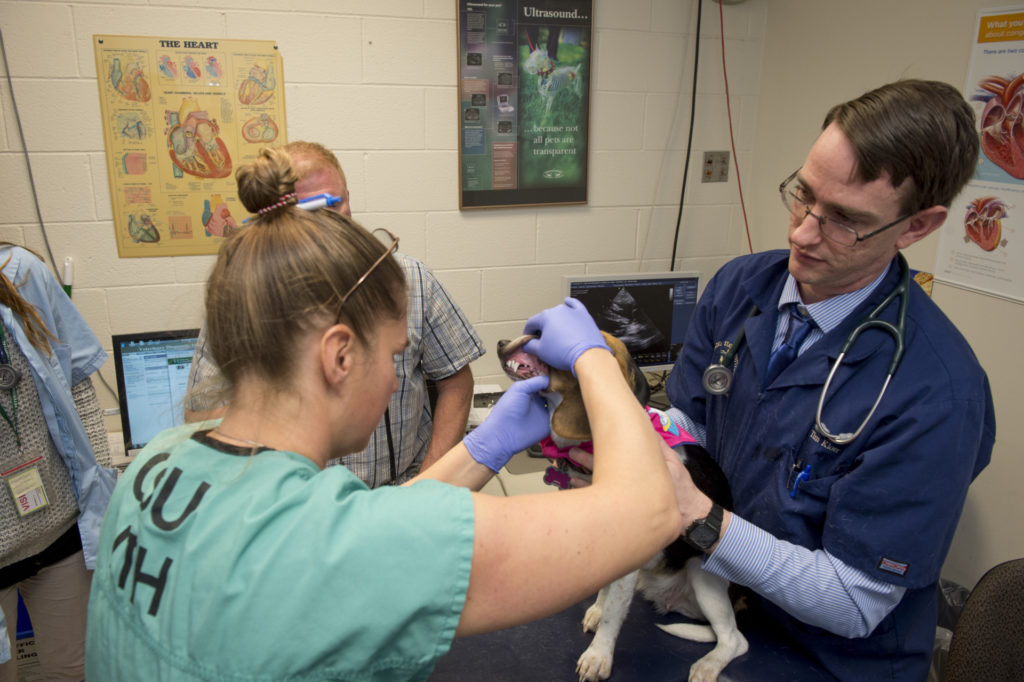
By Dr. Margie Smith
February is National Pet Dental Health Month, which makes it a great time to study up on the best ways to protect your pet’s oral health.
Our dog and cat patients at CSU’s James L. Voss Veterinary Teaching Hospital often have problems related to oral health. Signs of possible oral disease include:
- Dropping food
- Excessive drool
- Bleeding from the gums
- Halitosis, or bad breath
- Chewing on one side or the other
- Decreased appetite
- Decreased weight
- Head-shyness, shown by flinching or ducking behavior
Here are the top five things you need to know about what’s going on inside your pet’s mouth:
Periodontal disease is the No. 1 oral disease of dogs and cats over the age of 3

Up to 80 percent of dogs over the age of 3 have periodontal disease. This is a process that starts with inflammation of the gum tissue, known as gingivitis, progressing to attachment loss of the surrounding soft and hard structures. This can be a painful process that predisposes a pet to infection.
Periodontal disease begins with a layer of plaque that builds up on the surface of the tooth from naturally occurring bacteria in the mouth. This plaque then mixes with minerals in saliva leading to calcification, creating “calculus,” or the hard brown substance on dog’s teeth. In time, the bacteria, plaque and calculus spread under the gum line, leading to a reaction from the immune system. Progressive inflammation leads to attachment loss, deep pocketing, formation of abscesses, and tooth mobility.
Treatments like anesthesia-free dentistry address just the plaque and calculus above the gum line, leaving owners with a false sense of dental health. The real issue is beneath the gum line, where attachment loss begins.
Each animal’s response to bacteria in the mouth is different, but regular dental cleanings and daily at-home oral care can help prevent progression of periodontal disease.
At your annual exam, your veterinarian should be able to tell you if your pet is in need of a dental cleaning. This requires general anesthesia to take X-rays, chart the mouth to look for pockets indicating soft and hard tissue loss, and a cleaning above and below the gum line. At that time, any necessary extractions or additional treatments may be performed.
Daily brushing at home with a soft-bristled pediatric toothbrush and veterinary approved toothpaste will help decrease the accumulation of plaque and slow the progression of periodontal disease.
Fractured teeth can cause discomfort and lead to infection
Fractured teeth can be painful and lead to bacteria entering the blood and nerve supply of the tooth (pulp). This can create an infection at the root of the tooth, which can be very painful due to inflammation of the surrounding bone.
Fractured teeth should not be ignored, even if your pet appears to be comfortable. Detecting oral pain in pets is very difficult. Infection within the mouth may lead to seeding of bacteria in other organ systems in the body including the heart, liver and kidneys.
Tooth resorption is common in cats and can be very painful; extraction is needed
A common condition affecting cats is tooth resorption. Cats’ teeth undergo a process called “tooth resorption,” meaning the body is eating away the dentin of the tooth. This is a very painful process and affects a large number of our cat population.
This process will increase in frequency with age and may cause cats to stop eating or have difficulty eating hard food and grooming.
We do not know what causes this process. Unfortunately, the only treatment is extraction of the affected teeth to decrease oral pain. Generally, cats are much happier once the painful teeth are removed. They usually return to grooming and eating about two weeks after the procedure, once extraction sites are healed.
Gingivostomatitis is a chronic inflammatory disease that is extremely debilitating to small animal patients
Another feline oral condition is gingivostomatitis, a chronic inflammatory disease affecting the mucosa, the soft tissue that lines the oral cavity. This is an extremely debilitating disease and will cause a cat to be unwilling or unable to eat and drink.
We believe this disease is caused by an exaggerated immune response to an immune system stimulant, such as plaque, bacteria or a virus. The immune response leads to chronic and often ulcerative inflammation of the oral tissues around the teeth and the back of the mouth. In cats, this process often requires extractions of all teeth in the back of the mouth. In dogs, a similar process is called chronic ulcerative paradental stomatitis and is often noted over the canine teeth and large chewing teeth.
Treatment involves rigorous at-home oral care for remaining teeth, antibiotics, immunosuppressive drugs and frequent professional dental cleanings.
Oral exams can help identify tumors
There is much that can be learned from a thorough oral exam, including the identification of oral tumors, which make up about 10 percent of all tumors in dogs. While some of these are benign, some of them are malignant and should be diagnosed swiftly for the best prognosis.
We encourage all pets to have annual exams and a thorough oral exam. Oral health will help promote good overall health and help your pet to live a happy, healthy life. Now you and your pet are ready to ace this dental health quiz from the American Veterinary Medical Association.
Dr. Margie Smith is a veterinarian and post-doctoral fellow in the Dentistry and Oral Surgery service at Colorado State University’s James L. Voss Veterinary Teaching Hospital.